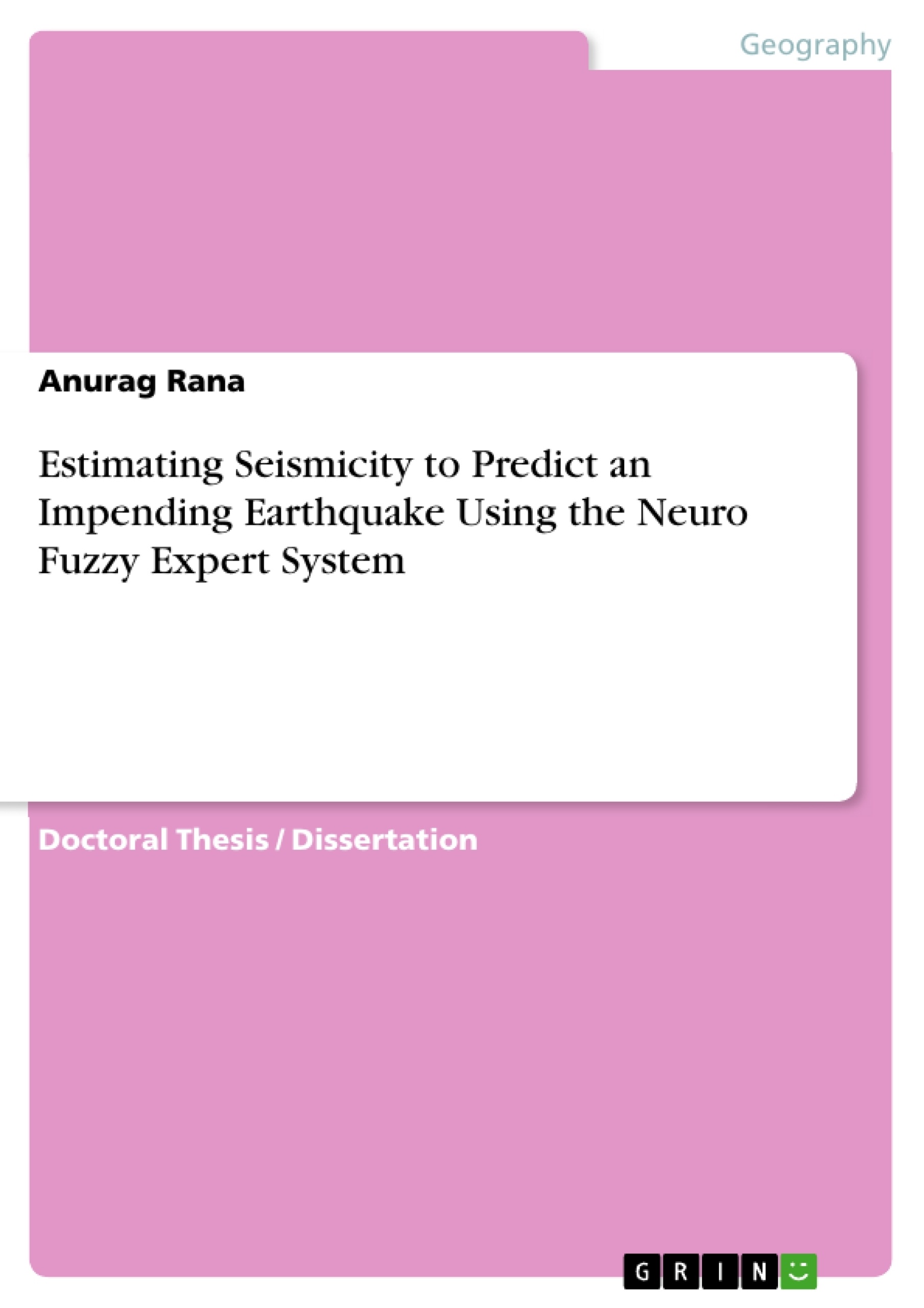This thesis proposes the use of a Neuro Fuzzy Expert System (NFES) for the estimation of earthquake seismicity and prediction of impending earthquakes. The study uses earthquake data collected from seismic monitoring stations in a specific region and applies NFES to analyze the data and predict the likelihood of future earthquakes.
This thesis focuses on the analysis of earthquake data to gain insights into the patterns and characteristics of seismic activity. The study utilizes a dataset of earthquake records collected from various seismic monitoring stations around the world. The data is processed and analyzed using statistical and machine learning techniques to identify trends, patterns, and relationships in the seismic activity.
Inhaltsverzeichnis (Table of Contents)
- ACKNOWLEDGMENT
- LIST OF ABBREVIATIONS
- CHAPTER 1: INTRODUCTION
- 1.1 INTRODUCTION
- 1.2 NEED OF THE RESEARCH
- 1.3 RESEARCH OBJECTIVES
- 1.4 SCOPE OF THE RESEARCH
- 1.5 ORGANIZATION OF THE THESIS
- CHAPTER 2: LITERATURE REVIEW
- 2.1 SEISMICITY ESTIMATION
- 2.2 SEISMICITY ESTIMATION METHODS
- 2.3 ARTIFICIAL NEURAL NETWORKS (ANN)
- 2.4 FUZZY LOGIC
- 2.5 NEURO-FUZZY SYSTEM
- 2.6 APPLICATIONS OF NEURO-FUZZY SYSTEMS IN EARTHQUAKE PREDICTION
- 2.7 EARTHQUAKE EARLY WARNING SYSTEM (EEWS)
- CHAPTER 3: DATA COLLECTION AND ANALYSIS
- 3.1 INTRODUCTION
- 3.2 DATA COLLECTION AND DESCRIPTION
- 3.3 DATA PRE-PROCESSING
- 3.4 DATA ANALYSIS
- CHAPTER 4: DESIGN AND IMPLEMENTATION OF NEURO-FUZZY EXPERT SYSTEM
- 4.1 INTRODUCTION
- 4.2 DESIGN OF NEURO-FUZZY EXPERT SYSTEM
- 4.3 TRAINING AND TESTING OF THE MODEL
- 4.4 PERFORMANCE EVALUATION METRICS
- CHAPTER 5: RESULTS AND DISCUSSIONS
- 5.1 INTRODUCTION
- 5.2 RESULTS AND DISCUSSIONS
- 5.3 CASE STUDY
- CHAPTER 6: CONCLUSIONS AND FUTURE SCOPE
- 6.1 INTRODUCTION
- 6.2 CONCLUSIONS
- 6.3 FUTURE SCOPE
- REFERENCES
Zielsetzung und Themenschwerpunkte (Objectives and Key Themes)
This research aims to develop a reliable and accurate Neuro-Fuzzy Expert System (NFES) for estimating earthquake seismicity and predicting impending earthquakes. The study leverages computational intelligence techniques and applies them to earthquake prediction, focusing on the development of a sophisticated system that can accurately assess and predict seismic activity.
- Earthquake Seismicity Estimation: The research explores and implements advanced computational methods for estimating earthquake seismicity. These methods involve analyzing historical seismic data and employing sophisticated algorithms to predict future seismic activity.
- Neuro-Fuzzy Expert Systems: The study focuses on the design, development, and implementation of a robust Neuro-Fuzzy Expert System (NFES) for earthquake prediction. NFES combines the strengths of Artificial Neural Networks (ANN) and Fuzzy Logic, creating a powerful tool for analyzing and predicting complex patterns in earthquake data.
- Earthquake Early Warning Systems: The research investigates the potential of the developed NFES to contribute to the development and improvement of Earthquake Early Warning Systems (EEWS). The goal is to enhance the accuracy and effectiveness of EEWS by integrating the NFES's advanced prediction capabilities.
- Data Analysis and Pre-processing: The study emphasizes the importance of data analysis and pre-processing techniques in earthquake prediction. It explores various methods for cleaning, analyzing, and preparing earthquake data for effective utilization in the NFES.
- Performance Evaluation Metrics: The research examines the performance of the developed NFES using established evaluation metrics. It assesses the system's accuracy, reliability, and overall effectiveness in predicting earthquake events.
Zusammenfassung der Kapitel (Chapter Summaries)
- Chapter 1: Introduction
- Chapter 2: Literature Review
- Chapter 3: Data Collection and Analysis
- Chapter 4: Design and Implementation of Neuro-Fuzzy Expert System
- Chapter 5: Results and Discussions
This chapter provides an overview of the research, highlighting the importance of earthquake prediction and the need for reliable systems. It outlines the research objectives, scope, and the organization of the thesis.
This chapter presents a comprehensive review of existing literature on earthquake seismicity estimation, seismic prediction methods, artificial neural networks, fuzzy logic, and neuro-fuzzy systems. It explores the use of these techniques in earthquake prediction and the development of earthquake early warning systems.
This chapter focuses on the methodology of data collection and analysis. It describes the data sources, data pre-processing techniques, and the statistical analysis of earthquake data used in the research.
This chapter outlines the design and implementation of the Neuro-Fuzzy Expert System (NFES) developed for earthquake seismicity estimation and prediction. It explains the system architecture, training and testing procedures, and performance evaluation metrics.
This chapter presents the results obtained from the application of the NFES, including its performance evaluation using various metrics. The results are discussed in relation to the research objectives and existing literature.
Schlüsselwörter (Keywords)
The research primarily revolves around the application of computational intelligence techniques to earthquake seismicity estimation and prediction. Key terms include: earthquake seismicity, Neuro-Fuzzy Expert System (NFES), Artificial Neural Networks (ANN), Fuzzy Logic, Earthquake Early Warning Systems (EEWS), data analysis, performance evaluation metrics.
- Quote paper
- Anurag Rana (Author), 2022, Estimating Seismicity to Predict an Impending Earthquake Using the Neuro Fuzzy Expert System, Munich, GRIN Verlag, https://www.grin.com/document/1403163



